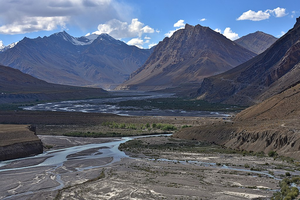Shimla: Authorities in Himachal Pradesh’s cold deserts of Spiti Valley will be starting a new initiative next month for low-income groups to have a “healthy” pregnancy free of anxiety.

Normally, they have to travel long distances to reach a hospital. The high cost of transportation is a challenge for pregnant women.
Launching on January 26, 2024, in the initial phase only pregnant women will benefit from the Life Saving Bank, a government spokesperson confirmed.
“As the bank becomes stronger, patients suffering from life-threatening diseases like cancer and heart attack will be included in the Life Saving Bank,” said the spokesperson.
A committee, headed by the Additional Deputy Commissioner, posted at Kaza, the headquarters of Spiti, some 320 km from the state capital Shimla, has been formed for the bank operation. Besides, heads of other government departments will be member secretaries.
It has been made mandatory for every member of the bank to pay the prescribed fee.
The Life Saving Bank will play an important role in helping women such as Sakhi. The poor women of Spiti will not have to wander here and there for financial help. This initiative will resolve their problems.
Giving information, Additional Deputy Commissioner Rahul Jain said the Life Saving Bank is a different kind of initiative that in the first phase will help those pregnant women who are financially weak.
“This includes poor women, including below poverty line (BPL) families. I hope many people of Spiti will benefit from this initiative. As the bank’s revenue increases, the bank will also help patients suffering from serious diseases,” he said.
The pregnant women have to go to Shimla, Kullu, and Mandi for delivery. Due to poor financial conditions, they are unable to bear the expenses. In such a situation, the bank aims to help such people.
“Women in low-income groups experience worse care during pregnancy, with the most deprived of better healthcare in Spiti. This initiative will ensure healthy deliveries and a path forward to support those who are at risk of multiple health issues,” Tashi Dolam, a Spiti woman said.
A century ago Rudyard Kipling in his novel “Kim” described Spiti as “a world within a world” and a “place where the god lives”. Things have hardly changed there.
A part of the remote but picturesque Lahaul-Spiti district, the Spiti valley, a cold desert dotted by tiny helmets spread over the Himalayan peaks, adjoining Tibet, takes you to a land of Buddhism and virgin nature.
Nearly 1,500 farmers in the Spiti Valley, with a population of 12,000, are doing natural farming with no chemicals. They have also been growing other vegetable crops like cabbage, cauliflower, and barley.
Cultivation of exotic vegetables in polyhouses is also coming up in a big way.
The entire Spiti Valley is populated mainly by Buddhists. The climatic conditions of the district are harsh as much of the land forms part of a cold desert where the mercury drops below minus 20 degrees Celsius during winter.
Courtesy: “IANS”
A seasoned journalist with over two decades of experience, Vishal writes on a wide range of subjects which include biodiversity, climate change and links between environment & development. He also covers politics and other developments in Punjab and Himachal Pradesh. He lives in Chandigarh & Shimla.



